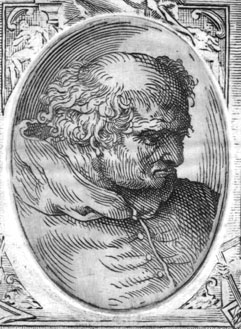Celebrazioni Bramantesche
25L Progetto della cupola di San Pietro - Design of the dome of St. Peter
90L Ritratto di Bramante - Portrait of Bramante
130L Sezione di scala - Section of scale
Biography:
Donato Bramante (b. 1444, Monte Andruvaldo, d. 1514)
Bramante was the leading architect of the High Renaissance in Italy. He was born in Monte Andruvaldo, near Urbino. Bramante was trained as a painter. His architectural career began in Milan, where he settled in 1482. In his design for the Church of Santa Maria presso Santo Satiro (1488), he used false perspective in the painted apse to create a feeling of depth-the first time this device had been used in architecture. Bramante left Milan in 1499 and settled in Rome, where, until the end of his life, he was employed almost exclusively by Pope Julius II. Here, under the influence of classical antiquity, his style became more monumental and less ornamented.
His two greatest projects, which occupied his most creative years but which did not reach completion, were his plans for the rebuilding of Saint Peter's Church and the Vatican Palace. His design for St. Peter's called for a large square building surmounted by a central dome, plus four smaller subsidiary domes and four towers. The piers and arches that were to support the dome were actually built, but before the structure could be finished, the design was radically altered by both Michelangelo and Carlo Maderno; St. Peter's was completed by Maderno in its present form of a longitudinal, rectangular basilica. Bramante's plan for additions to the Vatican Palace, on a 275-m (900-ft) sloping site, consisted of three successive courts surmounted by grandiose tiered landings. The plan was notable for its innovative axial arrangement and for its wonderful spaciousness, but it was never fully executed, and later additions completely spoiled its proportions.
Bramante stands with Michelangelo and Raphael as one of the artistic giants of the High Renaissance in Italy. Successfully fusing the ideals of classical antiquity with those of Christian inspiration, his sculptural, expressive grandeur paved the way for the more elaborate baroque school of the next century. He died in Rome on March 11 or April 11, 1514.




Δεν υπάρχουν σχόλια:
Δημοσίευση σχολίου